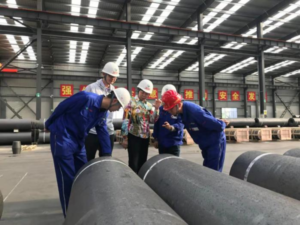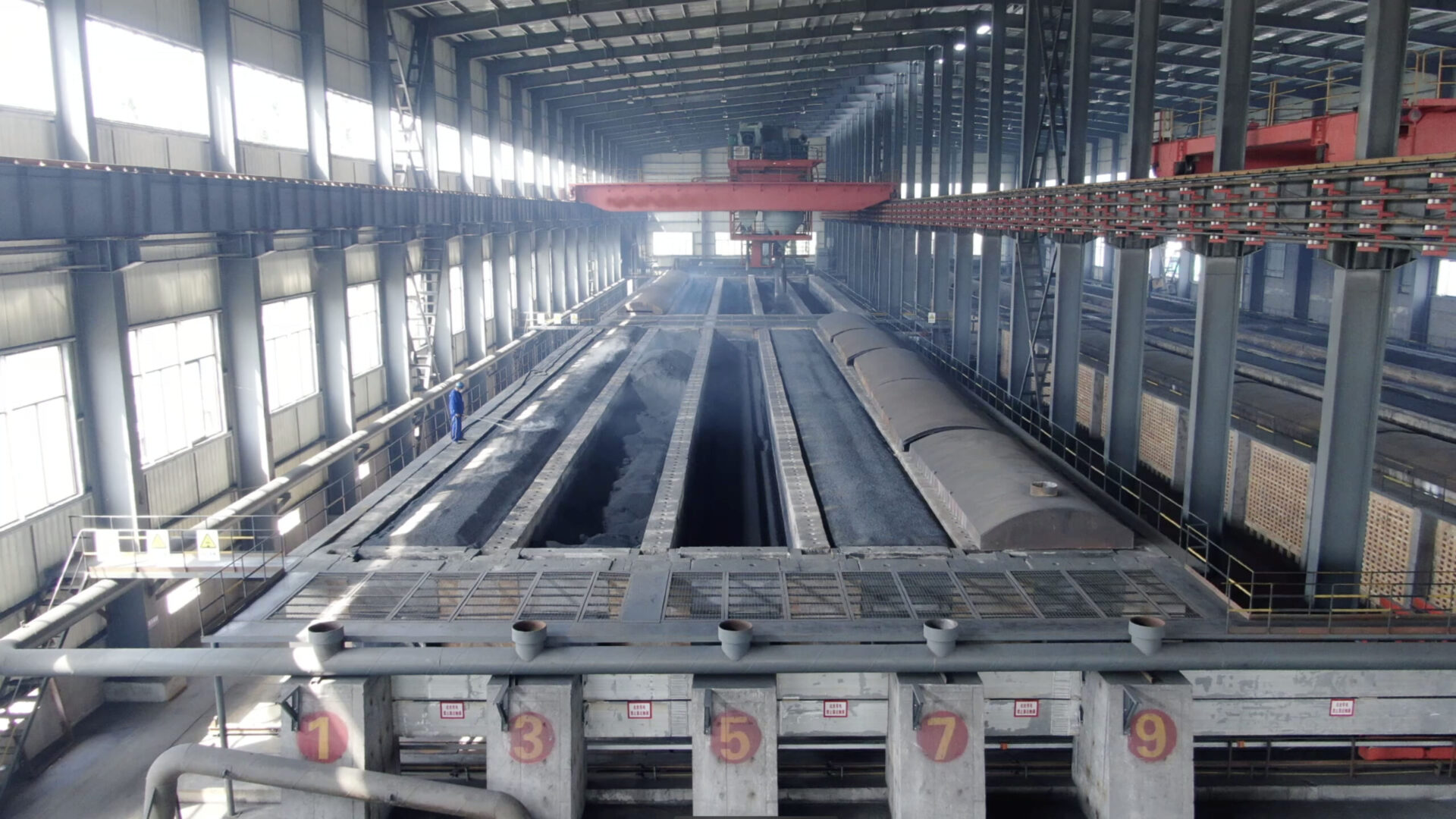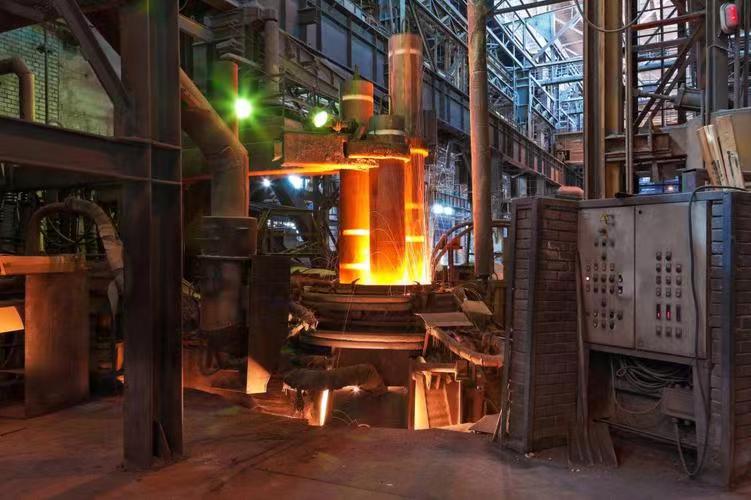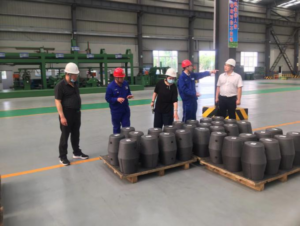L'elettrodo di grafite del forno elettrico ad arco è utilizzato nella produzione di acciaio. I forni che utilizzano l'energia elettrica come fonte di calore per la produzione di acciaio sono chiamati collettivamente forni elettrici. L'elettrodo di grafite è cilindrico, un conduttore con fori filettati alle due estremità.
Indice dei contenuti
ToggleElettrodi di grafite per forni elettrici ad arco per la produzione di acciaio.
Attualmente, la fusione in forno elettrico ad arco rappresenta oltre 95% dei metodi di produzione dell'acciaio in forno elettrico nel mondo. Pertanto, comunemente nota come siderurgia da forno elettrico, ci riferiamo principalmente alla siderurgia EAF.
In base alle caratteristiche della corrente, esistono due tipi di forni elettrici ad arco in corrente alternata e forni elettrici ad arco in corrente continua.
Nella tradizionale produzione di acciaio con forno elettrico ad arco in c.a.
La materia prima principale è il rottame d'acciaio e la fonte di energia è una corrente alternata a tre vie.
Questo processo utilizza principalmente l'arco generato tra l'elettrodo di grafite e il materiale metallico, per poi passare attraverso il potente calore dell'arco.
Si tratta quindi del metodo principale di produzione di acciai speciali e ad alta lega.
Materie prime degli elettrodi di grafite per forni elettrici ad arco.
Le materie prime degli elettrodi di grafite artificiale sono principalmente coke di petrolio e coke di pece. È cokizzato da coke di petrolio e pece di catrame di carbone, quindi è una materia prima ideale con basse ceneri e facile grafitizzazione.
Nel processo di produzione degli elettrodi di grafite. In primo luogo, la materia prima viene frantumata in particelle di dimensioni adeguate; in secondo luogo, viene inviata nel calcinatore per il trattamento termico a 1000-1300 gradi Celsius.
In questo modo, eliminiamo l'umidità e i volatili dalla materia prima, migliorandone le prestazioni. Queste proprietà includono la resistenza meccanica e la conducibilità elettrica.
Che cos'è il processo di grafitizzazione?
Il grafitizzazione è una parte fondamentale del processo di elettrodo di grafite. A pressione normale e a temperature superiori a 2200 gradi Celsius, si verificano dei cambiamenti. Allinea gli atomi di carbonio del coke di petrolio e del coke di pece.
Trasformarsi lentamente da una struttura stratificata casuale bidimensionale a una disposizione ordinata tridimensionale delle particelle di grafite.
La qualità della grafitizzazione ha un'influenza significativa sulla qualità del prodotto. Il grado di cristallizzazione è legato alla conducibilità dell'elettrodo.
Per completare il processo di grafitizzazione utilizziamo un grande forno di grafitizzazione. Si tratta di un processo ad alta intensità energetica, che richiede 4500-5000 kWh per tonnellata di elettrodo.
Uso di elettrodi di grafite per forni elettrici ad arco.
Gli elettrodi di grafite sono materiali conduttori nel forno elettrico ad arco. Si eccitano per generare un arco e poi fondono varie leghe di acciaio, metalli non ferrosi e metalli rari nel processo siderurgico del forno elettrico ad arco (eaf).
L'elettrodo di grafite da forno ha un basso contenuto di impurità di ceneri, una buona conducibilità elettrica e una buona resistenza elettrica e non si scioglie o si deforma alle alte temperature. È un materiale conduttivo che si adatta alle alte temperature del forno elettrico ad arco.
L'acciaieria con forno elettrico ad arco consiste nell'introdurre corrente nel forno attraverso l'elettrodo di grafite durante il processo di produzione dell'acciaio fuso.
Dopo che il forte vento passa attraverso il gas all'estremità inferiore degli elettrodi, si genera una scarica ad arco e il calore generato dall'arco viene utilizzato per la produzione di energia elettrica. fusione rottami di acciaio.
Tipi di elettrodi di grafite.
Esistono tre tipi di elettrodi di grafite, UHP、HP e RP gradi. I forni elettrici a corrente continua, i forni elettrici a corrente alternata, i forni a siviera e i forni di raffinazione sono inseparabili da essi.
Il coke da ago è un nuovo tipo di coke da petrolio. È una materia prima per la produzione di grafite di grado UHP.
Nella produzione, scegliamo diametri diversi in base alla capacità del forno elettrico. Questa è l'esigenza della produzione di acciaio da forno elettrico.
Per realizzare gli elettrodi utilizzare continuamente, Produttori di elettrodi di grafite Spesso si utilizzano nippli filettati per collegare due elettrodi.
Informazioni sulla garanzia di qualità
La priorità di Jinsun è fornire ai propri clienti elettrodi di grafite della massima qualità. Poiché le prestazioni e l'affidabilità del prodotto sono fondamentali per il successo della vostra attività siderurgica, implementiamo rigorose misure di garanzia della qualità durante la produzione.
Selezione delle materie prime:
Selezioniamo con cura le migliori materie prime per i nostri prodotti. I nostri elettrodi sono realizzati principalmente con coke di petrolio, needle coke e pece di alta qualità, per garantire una purezza e una consistenza ottimali.
Processo di produzione:
I nostri impianti di produzione all'avanguardia utilizzano tecnologie e processi avanzati per produrli.
Seguiamo linee guida rigorose per la produzione, che comprendono la calcinazione precisa a temperature estremamente elevate, l'estrusione e la formatura del corpo verde, la cottura secondaria, l'impregnazione, la grafitizzazione e la lavorazione precisa. Ogni fase è attentamente monitorata per mantenere qualità e prestazioni superiori.
Controllo qualità:
Disponiamo di un team dedicato di esperti professionisti del controllo qualità che conducono ispezioni rigorose in ogni fase del processo di produzione.
Dall'analisi delle materie prime alla valutazione del prodotto finale, ci atteniamo a rigorosi standard di qualità internazionali per garantire che ogni elettrodo soddisfi i requisiti.

Test delle prestazioni:
Ogni elettrodo di grafite viene accuratamente testato per verificarne le prestazioni prima di lasciare la nostra fabbrica. Eseguiamo test per valutare proprietà chiave come la conduttività, la resistività e la precisione dimensionale. Questo garantisce che i nostri prodotti soddisfino o superino costantemente gli standard del settore.
Certificazioni e standard:
Aderiamo a certificazioni e standard riconosciuti a livello internazionale per verificare ulteriormente la qualità e l'affidabilità dei nostri prodotti.
Il nostro processo di produzione è conforme alla norma ISO 9001:2015, che garantisce la conformità dei nostri prodotti a rigorosi requisiti di qualità.
Conclusione
Gli elettrodi di grafite per forni elettrici ad arco sono utilizzati principalmente nel processo di produzione dell'acciaio e dei metalli fusi. Utilizza materie prime needle coke di alta qualità per produrre materiali conduttivi, suddivisi in diversi gradi e adatti alle diverse esigenze di fusione del forno elettrico.
Contattateci per ottenere elettrodi di grafite per forni elettrici ad arco di alta qualità.
Altre risorse:
Forno elettrico ad arco per la produzione di vapore.
Processo di produzione degli elettrodi di grafite.
Processo del forno elettrico ad arco.








